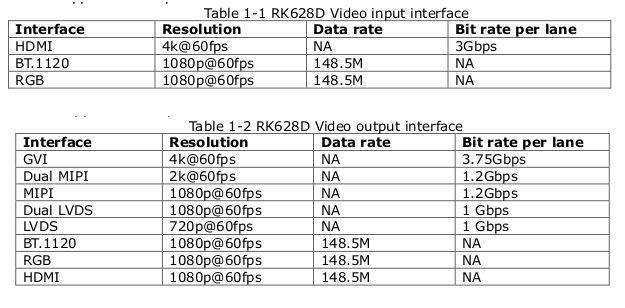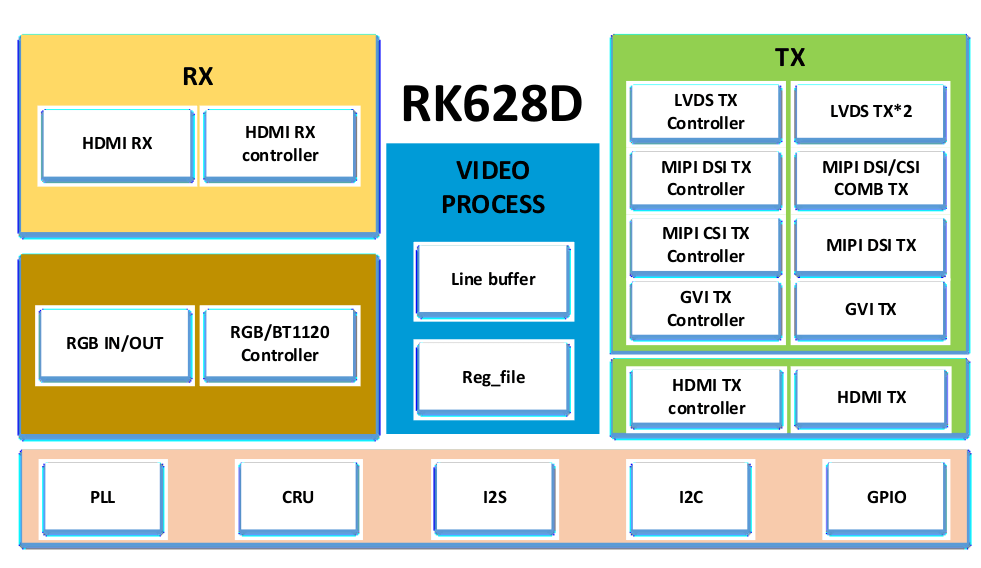If I’m asked about a Linux or Android platform with HDMI input, I would immediately think about Realtek RTD1295 SoC with products like Zidoo X9S or X2 TV stick which enabled picture-in-picture (PiP), UDP/TCP broadcast of HDMI input, or PVR functions.
Some Rockchip boards such as Orange Pi RK3399 SBC do come with both HDMI output and HDMI input, with the latter relying on a Toshiba TC358749XBG HDMI interface bridge IC. But Rockchip has decided to design its own HDMI input chip with Rockchip RK628D supporting HDMI, parallel RGB or BT.1120 as input and dual MIPI, dual LVDS, GVI (general video interface), parallel RGB, or BT.1120 as outputs. The new chip would enable PCB designers to add display output ports to application processors such as RK3288 or RK3399, or add an HDMI input interface.
Rockchip RK628D key features and specifications:
- Video input interfaces
- HDMI 1.4/2.0 RX interface up to 4Kp60 (yuv420) – Support 8-/10-bit, RGB888/YUV420, EDIC and CEC.
- Parallel RX interface up to 1080p60 supporting either 16-bit BT.1120 or 24-bit parallel RGB.
- Video output interface
- HDMI TX interface up to 1080p60 – Supports EDID and CEC functions
- MIPI TX interfaces
- DSI up to up to 2kp60 (dual-channel), 1080p60 (single channel); DPHY v1.2 compliant; Supports the DPI interface color-coding mappings into 24-bit Interface; Up to 4x DPHY Data Lanes per channel, supports data rates up to 1.2Gbps; dual-channel DSI0 and DSI1
- CSI compliant with MIPI DPHY V1.2; support YUV422 format, up to 4x DPHY Data Lanes with data rates up to 1.2Gbps; single-channel multiplexed with DSI0
- GVI TX interface up to 4Kp60; RGB666/RGB888/RGB101010/YCbCR422-8bit/YCBCR422-10bit formats
- LVDS TX interface up to 1080p60 (dual-channel), 720p60 (single channel); compliant with TIA/EIA-644-A LVDS standard
- Parallel TX interface up to 1080p60 using 16-bit BT.1120 out or 24-bit parallel RGB out
- TX/RX adapter
- Interaction of HDP signal between HDMI TX and HDMI RX
- Support HDMI TX CEC function
- Support RX HDCP1.3 inside-key memory (writable)
- Support HDMI RX/TX
- Support on-chip EDID R/W memory
- Post-process
- Color space conversion (CSC) – RGB2YUV, YUV2RGB, YUV2VYU
- Display interface – Parallel display Interface: 30-bit(RGB/YUV), asynchronous output pixel clock (PLL required), flexible display timing setting, configurable border black area
- Downscaling – Max input resolution: 4096×2160; Max 1/4 scaling ratio for bilinear scaling down, Max 1/6 scaling ratio for average scaling down
- Upscaling – Max output resolution: 4096×2160, supports four upscaling modes for different effect; Max 6 scaling ratio
- Split – Left-right mode; odd-even mode (LVDS only)
- Audio
- HDMI RX I2S interface, up to 48kHz sample rate, 8 channel
- Support I/O I2S interface, 8 channel
- Support HDMI TX I2S interface, 8 channel
- EFUSE – One-time programmable nonvolatile EFUSE storage cells organized
- Package – BGA144 (body: 8mmx8mm; ball size: 0.3mm; ball pitch: 0.65mm)
 The chip would allow you to add video output interfaces to Rockchip RK3399 by, for instance, connecting the HDMI output to RK628D HDMI input, and select output the video to LVDS, MIPI, RGB, etc… from the bridge chip. Alternatively, you could connect the RK628D MIPI CSI Tx interface to the processor’s MIPI CSI Rx interface to add HDMI input to your product.
The chip would allow you to add video output interfaces to Rockchip RK3399 by, for instance, connecting the HDMI output to RK628D HDMI input, and select output the video to LVDS, MIPI, RGB, etc… from the bridge chip. Alternatively, you could connect the RK628D MIPI CSI Tx interface to the processor’s MIPI CSI Rx interface to add HDMI input to your product.
More details can be found in the datasheet.

Jean-Luc started CNX Software in 2010 as a part-time endeavor, before quitting his job as a software engineering manager, and starting to write daily news, and reviews full time later in 2011.
Support CNX Software! Donate via cryptocurrencies, become a Patron on Patreon, or purchase goods on Amazon or Aliexpress. We also use affiliate links in articles to earn commissions if you make a purchase after clicking on those links.





Great news. I need that so much. My capture devices are very bad, a good SBC with HDMI-in could solve a lot of my headaches. I hope it’ll have good Linux support, and a powerful enough cpu for software recording. And maybe even hw enc.
Where the 8K resolution at?
I’m surprised that a RPI 400 doesn’t double as a laptop docking station with HDMI pass through.
I have a KVM switch for sharing a monitor and USB peripherals – A PiP mode that hotplugs a mouse and keyboard based on the active window could be intriguing.